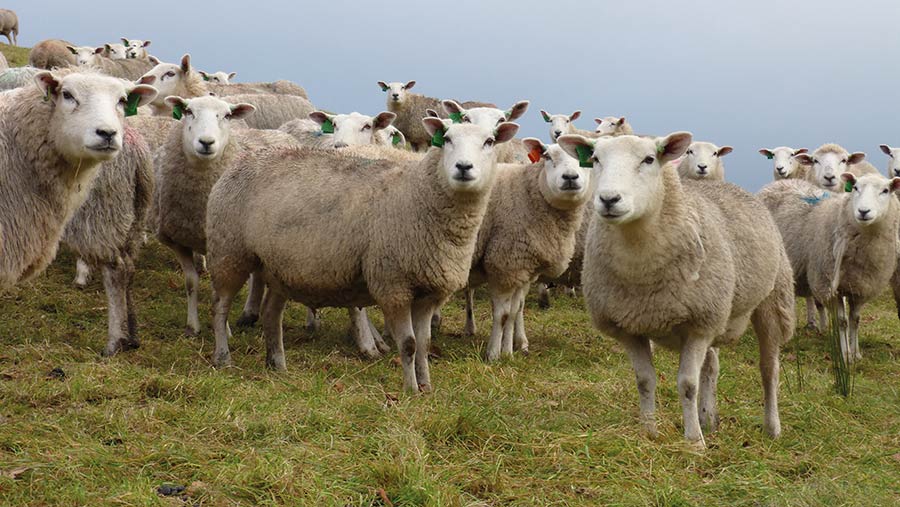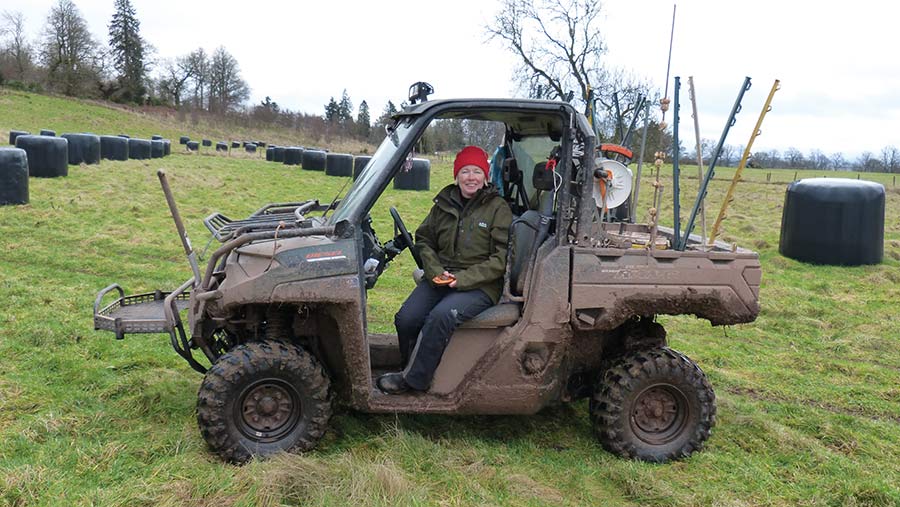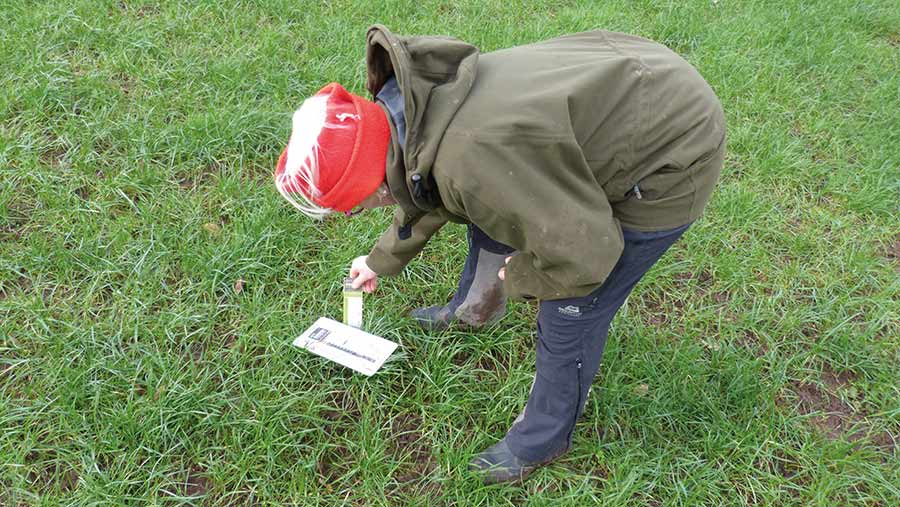How a Stirlingshire flock added £331/ha to lamb cheque
 © MAG/Michael Priestley
© MAG/Michael Priestley Eradicating an iceberg disease and ensuring grass is available at tupping and lambing has seen a 1,000-head flock lift output by 150 lambs a year since 2016.
It has been far from easy, but Colina Humphrey of Grainston Farm, Dunblane, is now £331/ha (£134/acre) better off (see “Farm output has lifted 139kg/ha (at £76 for a 32kg store lamb) which is £331/ha”).
The carrying capacity of the farm has doubled, allowing sheep numbers to lift from 850 to 1,000, cattle to be summered on surplus grass and 300 ewe hoggs to be tupped, with no increase in bought-in feed, and only 35kg/ha strategically used nitrogen.
See also: How to budget and allocate rotational grazing for ewes
Simple system
Mrs Humphrey returned home in 2016 to be more involved with the family farm after living in south-east England, working as a chartered accountant, becoming a mother and overseeing two self-build projects.
She vowed to improve flock health and develop a system “somebody 5ft 1in could do”.

Colina Humphrey © MAG/Michael Priestley
“I see myself as a low-input, grass-based store lamb producer trying to run a system I can cope with largely by myself,” says Mrs Humphrey.
“After weaning, it’s easier to budget grass for tupping and the next spring if I’m not worrying about finishing lambs.
“I value my time and work/life balance. The past three years I’ve sold 60-90% of lambs store. Most are gone by late September.”

© MAG/Michael Priestley
Two teenagers from a local farm are hired in on big yarding days and a shepherdess comes for five weeks to help with lambing and tagging.
A pneumatic weigh crate and sheep drafter and a lamb docking chute make sorting, tailing and castrating physically easier. All lambs are adopted onto ewes, so no pet lambs are fed.
Farmers Weekly asks about the three big changes at Kilbryde Farms.
Kilbryde Farms facts
- 208ha (514 acres) of grassland
- 1,314 sheep to lamb this year
- Stock sold at Stirling Caledonian Marts
- 60 cattle summered for 12-14 weeks (May to August)
- Red sandstone soils and peatier soils up the hill
- 1,049mm of rainfall/year
1. Rotational grazing
Back in 2014, grass shortages at tupping and lambing and grass going to seed in summer were proving challenging. This was corrected by:
Prioritising best ground for rotational grazing
The lowest parts of the farm (an 85ha [210-acre] area of former dairying ground) have been reseeded over a 10-year period with a clover and ryegrass mix with resilient, deep-rooting grasses (timothy, fescues and cocksfoot).
Between 2014 and 2020, the 18 fields in this area were subdivided into 53 paddocks using a mix of permanent and temporary fencing.
These are grazed from March to December. Mains electricity was extended to the grazing platform in 2016.
An intermediate area of 31ha (76 acres) of undulating grass parks and 47ha (116 acres) of rushy/boggy ground at the top of the farm have been partly reseeded, subdivided and improved by rotational grazing.
Average paddock size has fallen from 2.5ha (6 acres) to 1.6ha (3.9 acres). This allows grass to be rotationally grazed before lambing and means the “golden 20 rule” can be observed, which involves giving sheep a fresh paddock daily for the 10 days before and after the tups go in so they can preferentially graze and get flushed to scan well.
The farm rates this method and stretches it to 20 or more days before and during tupping.
Measuring pasture at key times
A rising plate meter is used to measure grass and calculate average farm cover (AFC) on the first day of each month during key points in the year (October to December and March to June).
AFC determines how long grazing will last, whether fields can be shut up to silage and how much feed will be made.
120 days’ rest for lambing paddocks
The aim is to put all twin- and triplet-bearing ewes back onto a pre-lambing rotation from mid/late March, shifting them daily to a fresh paddock, allowing paddocks to recover before being set-stocked in mid-April for lambing.
If there is sufficient cover, no supplements are fed in the run-up to lambing.
Silage is fed mid-gestation (January to March) when ewe needs are moderate. Half a bale of silage is budgeted for each ewe – a total of 690 bales last winter.
About half are set out on the rough permanent ground and electric fenced off until needed. Mobs of up to 400 ewes graze deferred grazing around the bales and ring-fed silage, accessing 10 bales at a time from January onwards every four or five days.
Best-quality silage is kept for mid-gestation hoggs and lambing time.
Taking more cuts of younger grass is lifting silage quality, which averaged 10.6MJ metabolisable energy (ME) and 12% crude protein last year, with some at 11.4MJ/kg dry matter (DM) ME.
This is made possible by local contractors that took eight silage cuts – 47ha (116 acres) once, 2ha (5 acres) twice.
A tine harrow and broadcasted grass seed addresses light poaching around ring feeders.
2. Outdoor lambing
Tupping date has been pushed back three weeks to late April and grassland management ensures sufficient grass – 1,700kg DM/ha – to lamb ewes outdoors.
Adopting outdoor lambing has ended the blanket use of oral antibiotics, allowed the farm to lamb more ewes with existing labour and saved money on straw and feed.
Previously, a total mixed ration was fed, and lambing was labour intensive, with all sheep kept in mothering-up pens.
Tupping hoggs (main priority group) are housed for 90 days on a 12MJ/kg DM ME silage before being put on grass to lamb near the steading for regular checks
The shed is mucked out and singles housed to lamb indoors. Triplets and hogg twins are lambed near the shed for fostering onto singles.
The farm has two quad bikes and a buggy for checking sheep twice daily.
Ewe lambs lamb to a Primera. Lleyn is the dominant maternal breed, with some Aberfield and Highlander-crosses and Texels used as terminal sires. Sires have narrow shoulders and small heads to suit outdoor lambing.
Lambing or maternal issues are recorded on Border software and selection pressure will be lifted now that flock size is optimal.
3. Addressing maedi visna
Flock performance had long been disappointing, with the reason a mystery until November 2015, when Rhidian Jones of RJ Livestock Systems suggested doing a post-mortem on a skinny ewe.
The Scottish Agricultural College (SAC) lab found the ewe was positive for maedi visna (MV).
The following actions were taken:
- January 2016 Vets blood-tested every sheep on the farm. Data was shared with SAC vets to help research into MV. This kept costs down
- February 2016 With results showing that almost 45% of ewes had tested positive for MV, the flock was split at scanning and were managed and lambed separately as a “dirty flock” on one farm (Torrance) and the “clean flock” at home (Grainston)
- After weaning 2016 All the ewes in the dirty flock (about 450 head) were culled
- Autumn 2016 250 MV-accredited Lleyn ewes were bought from Janet Hill, Bute, and a further 250 added to the clean flock the following summer. Tups now only bought from MV-accredited flocks
- Tupping 2016 Residual home-bred ewes were run separately for two years and blood-tested annually for MV before tupping. This practice is ongoing
- Spring 2018 It was felt safe to combine the two flocks for ease of grazing and management
- Winter 2022 No MV positives have been found for three years.
